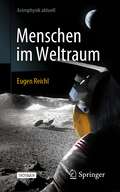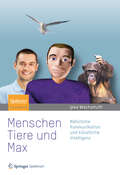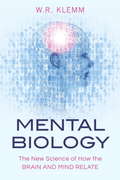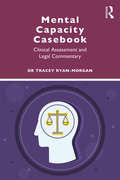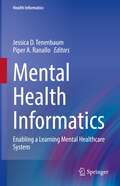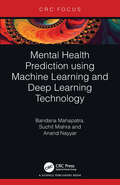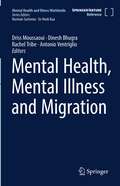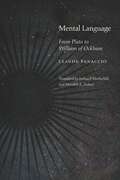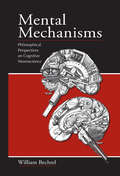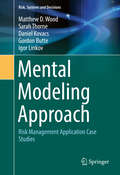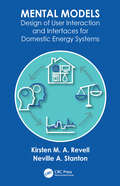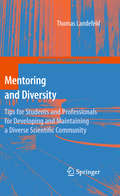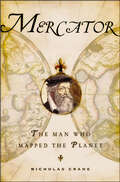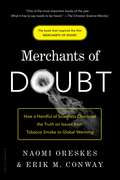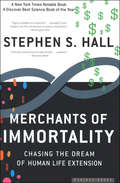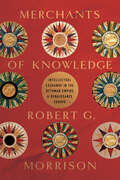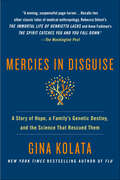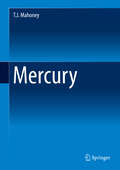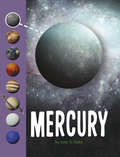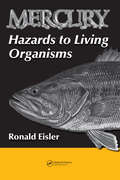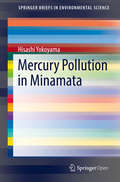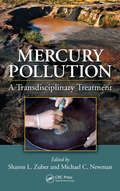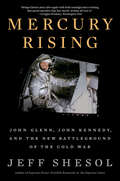- Table View
- List View
Menschen im Weltraum (Astrophysik aktuell)
by Eugen ReichlDieser Band der Astrophysik-Aktuell-Reihe beschäftigt sich mit der astronautischen Raumfahrt. Er beginnt mit den ersten Vorstellungen der Menschen über ihren Platz im Kosmos und erzählt die Geschichte ihrer Pioniere. Über den heute erreichten Status geht es weiter mit einem Ausblick in die Zukunft, wenn eine große Zahl von Menschen permanent im Weltraum leben wird und ein neues Zeitalter der „Fernreisen“ beginnt. Kurzweilig und verständlich stellt Eugen Reichl diese Entwicklungen und Zukunftsprojekte dar, unterstützt mit Statistiken und vielen Abbildungen.Menschen im Weltraum präsentiert die Entwicklung und Zukunft der astronautischen Raumfahrt im Stil der Astrophysik-Aktuell-Reihe. In kompakter Form richtet es sich an Schülerinnen und Schüler der Oberstufen, an Lehrkräfte mit Schwerpunkt Physik und Astrophysik, Studierende der Astronomie sowie der Luft- und Raumfahrt, aber auch ganz allgemein an alle, die sich für das Abenteuer des Menschen im Weltraum begeistern.
Menschen, Tiere und Max
by Ipke Wachsmuth"Nur selten fragt die Wissenschaft nach dem roten Faden, der Lebendiges mit Technischem, Mensch mit Tier und beide mit Computern oder Robotern verbindet. Dieses lesenswerte Buch ist ein brillanter Führer durch den Themendschungel - und unerlässlich für jeden, der sich über den Stand der Forschung informieren will." Gert Scobel, 3sat"Was ist Kommunikation? Ein Pionier des digitalen Zeitalters nimmt uns mit auf eine spannende Reise: von Menschen und Tieren zu Computern und Robotern, die uns zunehmend ähneln und zugleich verändern und in Frage stellen. Wer sind wir, und wie werden wir künftig miteinander umgehen? Zugleich augenzwinkernd und tiefgründig und vor allem immer authentisch baut Ipke Wachsmuth beim Leser nicht nur Unwissen ab, sondern auch Ängste und Sorgen." Manfred Spitzer, Autor von "Lernen" und "Medizin für die Bildung"Wie gelingt Kommunikation? Unter welchen Voraussetzungen verstehen wir einander? Wie lernen Kleinkinder, sich zu verständigen? Wie kommunizieren Tiere untereinander und mit uns? Und schließlich: Können Roboter und virtuelle Agenten zu vertrauenswürdigen und einfühlsamen Dialogpartnern und Helfern werden? Ipke Wachsmuth führt den Leser auf einen spannenden Streifzug durch die Vielfalt und Komplexität der kommunikativen Fähigkeiten. Immer wieder begegnet uns dabei Max, ein Kunstmensch aus der virtuellen Realität, an dem sich ganz konkret das Funktionieren von Kommunikation und Fragen über die Möglichkeiten künstlicher Intelligenz erörtern lassen. Aus dem Epilog: Ich erwache, weil Max mich ruft. Von der schimmernden Wand, die ein einziges riesiges Display ist und die hinter ihm nun das Tagespanorama von Seoul zeigt, begrüßt er mich mit fröhlichem Gesicht: "Guten Morgen, Ipke, acht Uhr! Ausgeschlafen? Du hast doch um zehn Uhr einen Termin." ... Jetzt aber los. Halt, wie war das noch mit der freundlichen Begrüßung? "Max? Wie sagt man nochmal ,Guten Tag' in Korea?" Max sogleich: "An-nyeong ha-se-yo", und weiter: "Du musst in einer Viertelstunde aufbrechen." Also doch noch Zeit für ein wenig Entspannung. "Max, gib mal etwas Musik." Er kennt ja meine Lieblingsstücke, aus meinem iTunes. Max wählt ein Bluesstück aus und tanzt dazu. Ich greife zum Couchtisch, wo meine Bluesharp liegt, und jamme etwas, variiere das eine oder andere, bis es richtig groovt. _____ Möwen, Krabben und Marktschreier - ausgehend von Alltagsbeobachtungen beleuchtet Ipke Wachsmuth in diesem Buch die Themen Kommunikation, natürliche und künstliche Intelligenz. Es geht dabei um Sprache und Denken, um Mimik und Gestik - und um die Komplexität hinter den so alltäglich erscheinenden kommunikativen Fähigkeiten von Menschen und Tieren. Das Buch führt auch in die Welt von Robotern und anderen künstlichen Wesen ein, die unseren künftigen Alltag mehr und mehr bevölkern werden. Max ist ein "lebendes" Beispiel dafür, wie die Schnittstelle zwischen Mensch und Computer in Zukunft aussehen könnte. Doch wie erzeugt man ausdrucksvolle Sprache? Wie lassen sich Gesichtsausdrücke technisch nachahmen? Welche Rolle spielt der Sprechrhythmus für unsere Kommunikation? Wie ist die hochentwickelte Wortsprache des Menschen entstanden, die uns von allen Tieren unterscheidet? Bildgebende Verfahren machen es heute möglich, dem Hirn beim Denken "zuzuschauen" und damit auch Einblicke in die Prozesse des Sprachverstehens zu erlangen, die man mit künstlicher Intelligenz nachzuahmen versucht. Zu den weiteren Themen des Buches gehören Gebärdensprachen, der Zusammenhang von Zeichen und Bedeutung sowie die Wirkung von spontanen Körperbewegungen und Körperhaltung für die Übermittlung von Botschaften. Spannend ist die Frage, inwieweit Tiere und Menschen sich über Bedeutsames austauschen können. Sind Menschenaffen in der Lage, Symbole zu gebrauchen und absichtsvoll zu kommunizieren, verfügen sie vielleicht sogar über Bewusstsein? Und wird sich ein Maschinenwesen wie Max eines Tages mit uns aus der Perspektive eines eigenen "Ich" unterhalten können? Maschinen mit "Eigenleben" - kann es und soll es die geben? Könnten sie einfühlsame Partner des Menschen werden...
Mental Biology
by W. R. KlemmA leading neuroscientist offers the latest research and many new ideas on the connections between brain circuitry and conscious experience.How the mysterious three-pound organ in our heads creates the rich array of human mental experience, including the sense of self and consciousness, is one of the great challenges of 21st-century science. Veteran neuroscientist W. R. Klemm presents the latest research findings on this elusive brain-mind connection in a lucidly presented, accessible, and engaging narrative. The author focuses on how mind emerges from nerve-impulse patterns in the densely-packed neural circuits that make up most of the brain, suggesting that conscious mind can be viewed as a sort of neural-activity-based avatar. As an entity in its own right, mind on the conscious level can have significant independent action, shaping the brain that sustains it through its plans, goals, interests, and interactions with the world. Thus, in a very literal sense, we become what we think.Against researchers who argue that conscious mind is merely a passive observer and free will an illusion, the author presents evidence showing that mental creativity, freedom to act, and personal responsibility are very real. He also delves into the role of dream sleep in both animals and humans, and explains the brain-based differences between nonconscious, unconscious, and conscious minds.Written in a jargon-free style understandable to the lay reader, this is a fascinating synthesis of recent neuroscience and intriguing hypotheses.
Mental Capacity Casebook: Clinical Assessment and Legal Commentary
by Tracey Ryan-MorganThe Mental Capacity Act 2005 (MCA) provides a legal framework for acting on behalf of individuals who lack the capacity to make decisions for themselves. The Mental Capacity Casebook showcases numerous real-life case studies in accordance to this Act. Through the exploration of various mental capacity assessments, this book highlights the psychological needs of the individuals who are supported and protected by the MCA. Dr. Tracey Ryan-Morgan, a Consultant Clinical Neuropsychologist, is the first to bridge the gap between the individual’s psychological requirements and the legal framework surrounding them. Not only does this book present true, often complex, mental capacity assessments, it does so with legitimate corresponding commentaries. Each case outlines the presented problem along with its background, social context, psychological matters, the overriding opinion and concluding learning points. This book provides a unique standpoint, offering insight into the complexities of the Act and practical guidance on how to conduct assessments. It serves as essential reading for those looking for guidance whilst making complex capacity decisions, such as Clinical Neuropsychologists, Social Workers, and Legal Professionals.
Mental Health Informatics: Enabling a Learning Mental Healthcare System (Health Informatics)
by Jessica D. Tenenbaum Piper A. RanalloThis textbook provides a detailed resource introducing the subdiscipline of mental health informatics. It systematically reviews the methods, paradigms, tools and knowledge base in both clinical and bioinformatics and across the spectrum from research to clinical care. Key foundational technologies, such as terminologies, ontologies and data exchange standards are presented and given context within the complex landscape of mental health conditions, research and care. The learning health system model is utilized to emphasize the bi-directional nature of the translational science associated with mental health processes. Descriptions of the data, technologies, paradigms and products that are generated by and used in each process and their limitations are discussed. Mental Health Informatics: Enabling a Learning Mental Healthcare System is a comprehensive introductory resource for students, educators and researchers in mental health informatics and related behavioral sciences. It is an ideal resource for use in a survey course for both pre- and post-doctoral training programs, as well as for healthcare administrators, funding entities, vendors and product developers working to make mental healthcare more evidence-based.
Mental Health Prediction using Machine Learning and Deep Learning Technology
by Anand Nayyar Bandana Mahapatra Suchit MishraToday the integration of technologies like Machine Learning (ML) and Deep Learning (DL) are enabling us to understand, predict, and manage the rising mental health concerns better. This volume provides a comprehensive roadmap for researchers, practitioners, and enthusiasts to explore how artificial intelligence can revolutionize mental healthcare. The book delves into the cutting-edge innovations in predictive modeling, offering insights into how ML and DL algorithms can analyze complex psychological data, detect early warning signs, and predict mental health outcomes. Designed for a diverse audience, including data scientists, mental health professionals, and students, it combines technical rigor with real-world applications. With case studies, hands-on examples, and future-forward discussions, this book empowers readers to contribute to the next wave of mental health solutions powered by AI.
Mental Health, Mental Illness and Migration (Mental Health and Illness Worldwide)
by Dinesh Bhugra Driss Moussaoui Rachel Tribe Antonio V. VentriglioThis book unravels the mental health challenges of the migrants and the socio economic and cultural conditions that bear on the mental well being. In addition, it covers the measures of intervention that can help the migrants maintain or restore their mental well being. Research included in the book is timely given that there is ever increasing mobility of people which on one hand has led to better livelihoods, but on the other has created conditions of stress for the migrants and their families. As migrants are often found to be hesitant of using the health care facilities in the new place which may be due to the lack of awareness, this book elaborates on the health care facilities, cost issues, stigma, and several other factors.
Mental Language: From Plato to William of Ockham (Medieval Philosophy: Texts and Studies)
by Claude PanaccioThe notion that human thought is structured like a language, with a precise syntax and semantics, has been pivotal in recent philosophy of mind. Yet it is not a new idea: it was systematically explored in the fourteenth century by William of Ockham and became central in late medieval philosophy. Mental Language examines the background of Ockham's innovation by tracing the history of the mental language theme in ancient and medieval thought.Panaccio identifies two important traditions: one philosophical, stemming from Plato and Aristotle, and the other theological, rooted in the Fathers of the Christian Church. The study then focuses on the merging of the two traditions in the Middle Ages, as they gave rise to detailed discussions over the structure of human thought and its relations with signs and language. Ultimately, Panaccio stresses the originality and significance of Ockham's doctrine of the oratio mentalis (mental discourse) and the strong impression it made upon his immediate successors.
Mental Mechanisms: Philosophical Perspectives on Cognitive Neuroscience
by William BechtelA variety of scientific disciplines have set as their task explaining mental activities, recognizing that in some way these activities depend upon our brain. But, until recently, the opportunities to conduct experiments directly on our brains were limited. As a result, research efforts were split between disciplines such as cognitive psychology, li
Mental Modeling Approach
by Igor Linkov Matthew D. Wood Sarah Thorne Daniel Kovacs Gordon ButteThis book provides an easy-to-read, user-oriented introduction to mental models research and Mental Modeling TechnologyTM. Mental models are powerful influences human behavior. The book offers insight from the developers and most experienced application professionals of a widely proven methodology for understanding and influencing human judgment, decision making and behavior. The case studies show examples of the methodological concepts in their application context. It is one of the most comprehensive collections of cases focused on government needs of any similar qualitative analysis approach. Finally, it presents an introduction to software tools and tutorials that enable readers to use the approach for their own research needs.
Mental Models: Design of User Interaction and Interfaces for Domestic Energy Systems
by Neville A. Stanton Kirsten M. RevellThere is a resurgence of interest in mental models due to advances in our understanding of how they can be used to help design and due to the development of practical methods to elicit them. This book brings both areas together with a focus on reducing domestic energy consumption. The book focuses on how mental models can be applied in design to bring out behaviour change resulting in increased achievement of home heating goals (reduced waste and improved comfort). This book also offers a method to extract and apply mental models to interface design. The approach enables mental models to be applied across domains when behaviour change was sought, and is validated as a useful design method.
Mentoring and Diversity
by Thomas LandefeldThis book will provide basic guidelines for facilitating the educational advancement of under represented students in the sciences, not only from the student perspective but also from the perspective of faculty advisors/mentors. Although the proper mentoring and advising of students about careers and preparation for the education and training associated with them is one of the most important components of a student's education process, this aspect has been severely lacking in academia in the past as well as the present. This is particularly the case with under represented ethnic minorities, despite the fact that mentoring of minority students has been identified as probably the most effective means for assisting them in achieving success. There are a multitude of reasons for this deficiency, including not enough mentors, students not "reaching out", lack of resources as well as other societal and academic limitations. This book provides tips to help guide a student on choosing mentors, what to expect from mentoring, and effectively developing a strong personal portfolio. Tips are also provided to scientists and faculty on being an effective mentor. The emphasis of the book will be primarily on students of color in the sciences, who are severely under represented, and will be presented in a "guidebook" format to simplify the process as much as possible.
Mercator: The Man Who Mapped the Planet
by Nicholas CraneAn enthralling biography of the man who created the first real map of the world and changed civilizationBorn at the dawn of the age of discovery, Gerhard Mercator lived in an era of formidable intellectual and scientific advances. At the center of these developments were the cartographers who painstakingly pieced together the evidence to create ever more accurate pictures of the planet. Mercator was the greatest of all of them-a poor farm boy who attended one of Europe's top universities, was persecuted and imprisoned by the Inquisition, but survived to coin the term "atlas" and to produce the so-called projection for which he is known. Devoutly religious, yet gripped by Aristotelian science, Mercator struggled to reconcile the two, a conflict mirrored by the growing clash in Europe between humanism and the Church.Mercator solved the dimensional riddle that had vexed cosmographers for so long: How could the three-dimensional globe be converted into a two-dimensional map while retaining true compass bearings? The projection revolutionized navigation and has become the most common worldview.Nicholas Crane-a fellow geographer-has combined a keen eye for historical detail with a gift for vivid storytelling to produce a masterful biography of the man who mapped the planet.
Merchants Of Doubt: How A Handful Of Scientists Obscured The Truth On Issues From Tobacco Smoke To Global Warming
by Naomi Oreskes Erik M. Conway"Merchants of Doubt should finally put to rest the question of whether the science of climate change is settled. It is, and we ignore this message at our peril."-Elizabeth Kolbert<P><P> "Brilliantly reported andwritten with brutal clarity."-Huffington Post<P> Now a powerful documentary from the acclaimed director of Food Inc., Merchants of Doubt was one of the most talked-about climate change books of recent years, for reasons easy to understand: It tells the controversial story of how a loose-knit group of high-level scientists and scientific advisers, with deep connections in politics and industry, ran effective campaigns to mislead the public and deny well-established scientific knowledge over four decades. The same individuals who claim the science of global warming is "not settled" have also denied the truth about studies linking smoking to lung cancer, coal smoke to acid rain, and CFCs to the ozone hole. "Doubt is our product," wrote one tobacco executive. These "experts" supplied it.
Merchants of Immortality: Chasing the Dream of Human Life Extension
by Stephen S. HallWhat biologists are doing for immortality.
Merchants of Immortality: Chasing the Dream of Human Life Extension
by Stephen S. HallA Discover Best Science Book of the Year: &“A fascinating, accurate and accessible account of some of [the] contemporary efforts to combat aging&” (The New York Times). Los Angeles Times Book Prize Finalist Named a Best Book of the Year by the New York Times, San Jose Mercury News, and Library Journal An award-winning writer explores science&’s boldest frontier—extension of the human life span—interviewing dozens of people involved in the quest to allow us to live longer, better lives. Delving into topics from cancer to stem cells to cloning, Merchants of Immortality looks at humankind&’s quest for longevity and tackles profound questions about our hopes for defeating health problems like heart attacks, Parkinson&’s disease, and diabetes. The story follows a close-knit but fractious band of scientists as well as entrepreneurs who work in the shadowy area between profit and the public good. The author tracks the science of aging back to the iconoclastic Leonard Hayflick—who was the first to show that cells age, and whose epic legal battles with the federal government cleared the path for today&’s biotech visionaries. Among those is the charismatic Michael West, a former creationist who founded the first biotech company devoted to aging research. West has won both ardent admirers and committed foes in his relentless quest to promote stem cells, therapeutic cloning, and other technologies of &“practical immortality.&” Merchants of Immortality breathes scintillating life into the most momentous science of our day, assesses the political and bioethical controversies it has spawned, and explores its potentially dramatic effect on the length and quality of our lives. &“Timely and engrossing . . . This is top-drawer journalism.&” —Publishers Weekly, starred review &“A carefully documented examination of how society deals with life-and-death matters.&” —Kirkus Reviews, starred review &“An important survey of the entire landscape of the science aimed at extending human life.&” —Newsday &“[This] highly readable and important book . . . provide[s] new insights into the intersection of science and politics.&” —The Washington Post
Merchants of Knowledge: Intellectual Exchange in the Ottoman Empire and Renaissance Europe (Stanford Ottoman World Series: Critical Studies in Empire, Nature, and Knowledge)
by Robert G. MorrisonBetween 1450 and 1550, a remarkable century of intellectual exchange developed across the Eastern Mediterranean. As Renaissance Europe depended on knowledge from the Ottoman Empire, and the courts of Mehmed the Conqueror and Bayezid II greatly benefitted from knowledge coming out of Europe, merchants of knowledge—multilingual and transregional Jewish scholars—became an important bridge among the powers. With this book, Robert Morrison is the first to track the network of scholars who mediated exchanges in astronomy, astrology, Qabbalah, and philosophy. Their books, manuscripts, and acts of translation all held economic value, thus commercial and intellectual exchange commingled—knowledge became transactional as these merchants exchanged texts for more intellectual material and social capital. While parallels between medieval Islamic astronomy and the famous heliocentric arrangement posited by Copernicus are already known, Morrison reveals far deeper networks of intellectual exchange that extended well beyond theoretical astronomy and shows how religion, science, and philosophy, areas that will eventually develop into separate fields, were once interwoven. The Renaissance portrayed in Merchants of Knowledge is not, from the perspective of the Ottoman Muslim contacts of the Jewish merchants of knowledge, hegemonic. It's a Renaissance permeated by diversity, the cultural and political implications of which the West is only now waking up to.
Mercies in Disguise: A Story of Hope, a Family's Genetic Destiny, and the Science That Rescued Them
by Gina Kolata"[Kolata] is a gifted storyteller. Her account of the Baxleys... is both engrossing and distressing... Kolata's book raises crucial questions about knowledge that can be both vital and fatal, both pallative and dangerous." —Andrew Solomon, The New York Review of BooksNew York Times science reporter Gina Kolata follows a family through genetic illness and one courageous daughter who decides her fate shall no longer be decided by a genetic flaw.The phone rings. The doctor from California is on the line. “Are you ready Amanda?” The two people Amanda Baxley loves the most had begged her not to be tested—at least, not now. But she had to find out.If your family carried a mutated gene that foretold a brutal illness and you were offered the chance to find out if you’d inherited it, would you do it? Would you walk toward the problem, bravely accepting whatever answer came your way? Or would you avoid the potential bad news as long as possible? In Mercies in Disguise, acclaimed New York Times science reporter and bestselling author Gina Kolata tells the story of the Baxleys, an almost archetypal family in a small town in South Carolina. A proud and determined clan, many of them doctors, they are struck one by one with an inscrutable illness. They finally discover the cause of the disease after a remarkable sequence of events that many saw as providential. Meanwhile, science, progressing for a half a century along a parallel track, had handed the Baxleys a resolution—not a cure, but a blood test that would reveal who had the gene for the disease and who did not. And science would offer another dilemma—fertility specialists had created a way to spare the children through an expensive process. A work of narrative nonfiction, Mercies in Disguise is the story of a family that took matters into its own hands when the medical world abandoned them. It’s a story of a family that had to deal with unspeakable tragedy and yet did not allow it to tear them apart. And it is the story of a young woman—Amanda Baxley—who faced the future head on, determined to find a way to disrupt her family’s destiny.
Mercury
by T. J. MahoneyThe purpose of this Gazetteer and Atlas of Astronomy (GAA) is to list, define and illustrate, for the first time, every named (as opposed to merely catalogued) object in the sky within a single reference work for use by the general reader, writers and editors dealing with astronomical themes, and those astronomers concerned with any aspect of astronomical nomenclature. Each part of the GAA will contain: * An introduction to the nomenclature of the body or group of bodies in question * A glossary of terminology used * A gazetteer listing in strict alphanumerical sequence essential information defining the body or feature concerned * An alphanumerically arranged classified index of all the headwords in the gazetteer * An atlas comprising maps and images with coordinate grids and labels identifying features listed in the gazetteer * Appendix material on the IAU nomenclature system and the transcription systems used for non-roman alphabets
Mercury (Exploring the Solar System)
by Giles SparrowWhat would it be like if you could travel to Mercury in a spaceship, land on its surface, and bound around in the low gravity? This book takes you on a mission to Mercury. Fly over the second-largest impact crater in the solar system, explore the deep cracks in Mercury's crust, and find out why a day lasts longer than a year on this tiny planet.
Mercury (Planets in Our Solar System)
by Jody S. RakeThe smallest planet in our solar system is also the closest to the sun. That means on Mercury, one year is just 88 days long! Discover more facts about the small but mighty Mercury.
Mercury Hazards to Living Organisms
by Ronald EislerComplex and ever changing in its forms and functions, the element mercury follows a convoluted course through the environment and up the food chain. The process is complicated further by the fact that the difference between tolerable natural background levels and harmful effects in the environment is exceptionally small and still not completely und
Mercury Pollution in Minamata (SpringerBriefs in Environmental Science)
by Hisashi YokoyamaThis book is open access under a CC BY 4.0 license. It overviews the poisoning which occurred in the 1950s and 1960s among the residents in Minamata who ate seafood contaminated with methylmercury discharged from the chemical factory, Chisso Corporation. It describes the history, symptoms pathogenesis and research on the causal agent, and discusses the responses of Chisso and the national and local governments to the outbreak, the victims, the compensation and environmental restructuring as well as the court ruling on claims. Based on lecture notes from a university course, it includes students’ suggestions for avoiding a repeat of the tragedy. The issue has not been settled yet, and this analysis of the incident provides useful insights into solutions to the current global mercury pollution problem.
Mercury Pollution: A Transdisciplinary Treatment
by Sharon L. Zuber Michael C. NewmanCRCHow does mercury get out of the ground and into our food? Is tuna safe to eat? What was the Minamata Disaster? Mercury Pollution: A Transdisciplinary Treatment addresses these questions and more. The editors weave interdisciplinary threads into a tapestry that presents a more complete picture of the effects of mercury pollution and provides new way
Mercury Rising: John Glenn, John Kennedy, And The New Battleground Of The Cold War
by Jeff ShesolOne of the Washington Post's 20 Books to Read This Summer A riveting history of the epic orbital flight that put America back into the space race. If the United States couldn’t catch up to the Soviets in space, how could it compete with them on Earth? That was the question facing John F. Kennedy at the height of the Cold War—a perilous time when the Soviet Union built the wall in Berlin, tested nuclear bombs more destructive than any in history, and beat the United States to every major milestone in space. The race to the heavens seemed a race for survival—and America was losing. On February 20, 1962, when John Glenn blasted into orbit aboard Friendship 7, his mission was not only to circle the planet; it was to calm the fears of the free world and renew America’s sense of self-belief. Mercury Rising re-creates the tension and excitement of a flight that shifted the momentum of the space race and put the United States on the path to the moon. Drawing on new archival sources, personal interviews, and previously unpublished notes by Glenn himself, Mercury Rising reveals how the astronaut’s heroics lifted the nation’s hopes in what Kennedy called the "hour of maximum danger."
